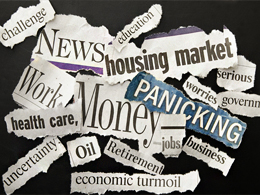 Rereading yesterday’s post, I’m reminded of our tendency to look for things to worry about. To me, fretting about the systemic problems of low energy prices and high savings rates is a stretch, a sign that we’ve run out of real concerns.
Rereading yesterday’s post, I’m reminded of our tendency to look for things to worry about. To me, fretting about the systemic problems of low energy prices and high savings rates is a stretch, a sign that we’ve run out of real concerns.
Eeyore to the rescue! Although I’ve been saying for the past couple of years that the recovery is real and strengthening, I’ve also made a point to keep an eye out for risks.
It all depends on the time frame
Part of the problem we face as investors is focusing on the appropriate time frame. This applies to likely investment returns and market valuations, but also to risks.
- Short-term risks tend to be either obvious (in which case, they’re priced in) or invisible (in which case, we can’t see them at all). Either way, they're not something we can affect.
- Long-term risks are typically just that, not near enough to require our immediate attention.
- The medium-term is where the need to potentially act, plus the lowered visibility of the nonimmediate, can combine to get us into trouble.
A look at some medium-term risks
So, what should we be focusing on? Let’s look at a few real medium-term risks.
Inflation. Today’s inflation figures were interesting in two ways:
- Energy was up for the first time in eight months, a sign that in the next six to eight months we can expect the substantial drop in energy prices to roll off the year-to-year comparisons, bumping up the CPI numbers.
- Shelter, the largest component of the CPI, was up by 3 percent, led by a 3.5-percent increase in rent—the highest level since November 2008.
We can reasonably expect inflation to increase by much more than current levels, starting around the end of this year. This will come as a surprise to many, and the effect on interest rates may be substantial.
Greece and Europe. At the moment, the European crisis has subsided, but the actual panic point continues to approach. Greece is running out of money and has presented no real plans to solve the problem. Germany becomes more politically conflicted about the eurozone by the day. There is an existential crisis looming, possibly by the end of the year. Never underestimate the ability of the Europeans to kick the can further down the road, but note that the end of the road has moved from the long term to the medium term.
Russia. Beyond oil, Russia has no economy. It does, however, have a very effective military. Putin can either decline into economic irrelevance or decide to use his military power. The recent record suggests he’s not planning for irrelevance, and the question now is what he plans to do next. I don’t know, but Russia certainly sits squarely on the list of medium-term risks.
China’s arguably on the list as well, but at this point, it’s still a longer-term problem. Notably absent are some of the current headline worries, including the “currency wars” meme. Now that I think of it, though, it’s probably worth walking through the currency situation in some detail. Let’s do that tomorrow.


 Print
Print


